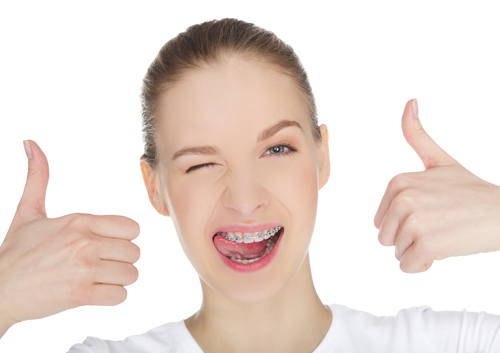February 24th, 2021

Today, Dr. Viney Saini and our team thought we would offer a few tips for our patients currently undergoing orthodontic treatment. For those of you wearing braces, it’s important to be even more dedicated to good oral hygiene than those not currently in treatment.
After getting your braces, it is important to know how to take care of your teeth in order to ensure that your braces stay intact and do their job so that your teeth are in top-notch condition after you complete your orthodontic treatment.
Braces are known to trap food, which contributes to plaque formation. If it is not carefully removed from the teeth and gums, plaque will develop into decay or gum disease, leading to costly delays during your treatment. It is important to practice good oral hygiene by following instructions from Dr. Viney Saini during your treatment.
We are proud to offer supplies to help fight plaque, such as a proxabrush, dental floss, and floss threaders. The use of an electric toothbrush and or a water pick can also be helpful in combating cavities and decay. And, of course, our team at Viney P. Saini Orthodontics suggests brushing at least twice a day.
We hope that helps! If you have any questions, please give us a call at our Clarksburg, MD and Frederick, MD office or ask us during your next adjustment appointment!
February 17th, 2021

Braces can straighten your teeth to give you a more attractive smile for life. The process can take 18 months to two years or more, and this amount of time can seem unending when you first get your braces. Counting down your brace time can help the time pass more quickly and build the excitement for when you finally get your braces removed.
Make a Wall Calendar
Crossing out each day on a calendar is a standard way of counting down time. You can make this more personal by designing your own calendar to help you count down. Use an online customization service to upload photos or designs for each month. Each month’s picture can also display the number of months remaining until you expect your braces to come off.
Schedule Rewards
When you receive regular rewards for continuing to wear your braces, they can seem less burdensome. Plan to buy yourself a reward every month that you wear your braces for the duration of the treatment. The time will pass much faster when you feel you are earning rewards for your patience.
Lengthen a Paper Chain
Use strips of paper to make the links of your chain, and add a new link each week to lengthen the chain. Before sealing each new strip of paper into a circle, write on it a reason why you are getting your teeth straightened, or an event in the future when you will appreciate your straight teeth as you smile.
Use a Wall Hanging
Purchase a large pad of blank white paper. Write a “0” on the bottom sheet and a “1” on the next, and continue until you reach the number of days remaining in your treatment. Rip off the top sheet each day to see how many days are left and remind yourself of the progress you are making.
Find a Buddy
If any of your friends get braces around the same time as you, share the experience. Make a pact to celebrate each trip to Viney P. Saini Orthodontics when one of you receives news about your progress.
February 10th, 2021

Valentine’s Day, also known as Saint Valentine’s Day, has been said to originate with a Catholic priest named Valentine several thousand year ago. Valentine defied the emperor at the time by secretly marrying men and their brides after the emperor had made it illegal to marry. Emperor Claudius II did this because he wanted as many single young men to fight in his war as he could get.
Valentine disobeyed the emperor’s edict by continuing to marry couples until he was sentenced to death. Before his execution, he sent a letter to a secret love and signed it “From your Valentine.” Dr. Viney Saini and our team have come up with some suggestions on how you can celebrate this Valentine’s Day, whether you have a valentine of your own or not.
Valentine's Day Ideas
- Enjoy a tasty treat. There are plenty of options when it comes to cooking and/or baking on Valentine’s Day. Make your significant other his or her favorite meal or sweet treat, or make your own favorite dish to enjoy on this day. Oh, and be sure to make enough for leftovers!
- Make a personalized card. Instead of buying a card from the grocery store, take the time to make your own for a loved one. People love handwritten notes, especially when it’s from someone special. If you’re single this Valentine’s Day, make a card for fellow single friend to brighten the day and remind the person that he or she is also loved.
- Watch a movie. We all know there are plenty of romance movies out there. Put on your favorite romantic comedy, or pick up your significant other’s favorite movie to watch together. Even better, if you’re single, pick up your own favorite movies to watch to pass the time this Valentine’s Day.
- Do nothing! We all know Valentine’s Day can sometimes get a lot of hype. If you’re worried about not making a reservation in time, don’t feel like planning an extravagant night out, or simply not in the holiday mood this year, spend your day sitting back and relaxing.
Valentine’s Day is a time to celebrate love and spend quality hours with the people you care about the most. Whether you’re in a relationship or single, take some time today to appreciate those you love in your life.
We wish you a happy Valentine’s Day celebration and look forward to seeing you at our Clarksburg, MD and Frederick, MD office during your next appointment.
February 3rd, 2021

Kids can be picky eaters. How many times have you seen your child try to hide the peas under a mound of mashed potatoes?
At Viney P. Saini Orthodontics, Dr. Viney Saini and our team understand how hard it can be to get your child to eat the recommended daily allowance of fruits and vegetables. The task of providing fun, nutritious meals becomes even more challenging if he or she wears braces. It's an age-old saying that breakfast is the most important meal of the day. These five braces-friendly recipes are not only nutritious, but they will have little Jimmy flashing his “tin grin” when he sits down at the kitchen table in the morning.
- Scrambled eggs are soft and easy to eat if you have braces. If you drown them in ketchup (which many kids love to do), eggs become even mushier. Minimal chewing is required, and that’s the key to a braces-friendly recipe.
- A healthy breakfast provides energy and jump-starts metabolism. A smoothie is not only a good source of fruit, but it’s also gentle on braces. More importantly, smoothies are fun to create. You can toss anything in the blender (bananas, mangoes, strawberries, spinach) and create a drink that’s loaded with vitamins and antioxidants.
- If you wear braces, eating crunchy cereals or granola for breakfast is out of the question: Bite down the wrong way and you might snap the wires or dislodge the brackets. However, you can get your grains and oats by substituting oatmeal for cereal. This mushy breakfast treat has a host of health benefits.
- Pancakes are not the healthiest breakfast choice. Still, this Sunday morning favorite is braces-friendly. The idea is to make it healthier by hiding blueberries in the pancake batter just like your child hides peas in the mashed potatoes.
- Toast with jam is ok, but skip slathering peanut butter on the bread. If you have braces, the general rule of thumb is to steer clear of foods that are hard or chewy. These types of foods can break wires. Of course, most kids will agree that toast isn’t the most exciting breakfast recipe. Make it a Pop-Tart instead!
For more braces-friendly recipes, please give us a call at our convenient Clarksburg, MD and Frederick, MD office!




